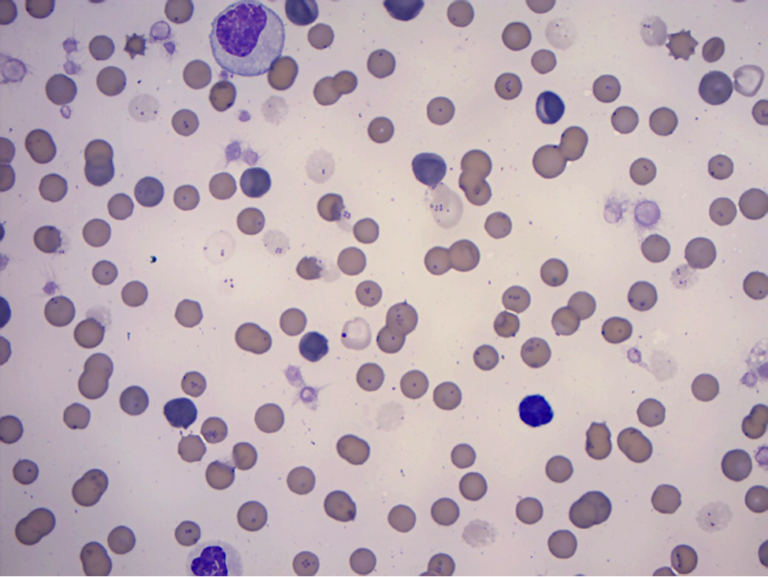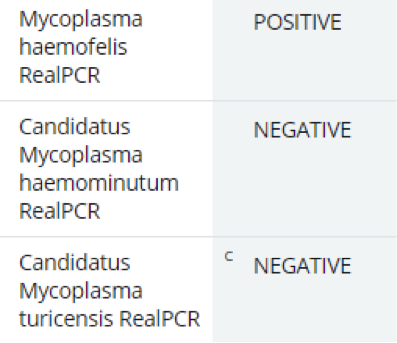A complete blood count (CBC) from a three-year-old male neutered domestic shorthair cat with severe anemia was submitted to IDEXX Reference Laboratory. No clinical history was received with the sample. Review the CBC (figure 1) and blood smears (figure 2 and 3) below.
What is Your Interpretation of this CBC and Blood Smears?
Selected CBC Results

Figure 1. Select CBC results from a 3-year-old anemic cat.

Figure 2. Blood Smear Examination from a 3-year-old anemic cat. 100x Objective.

Figure 3. Blood Smear Examination from a 3-year-old anemic cat. 100x Objective.
What is Your Interpretation?
Pathologist’s Review of the Cytology Slides
Here is the pathologist’s review of the CBC and blood smear:
There is severe anemia, and the red blood cells have moderate anisocytosis and marked polychromasia consistent with a regenerative anemia. The increased number of nucleated red blood cells may be present in association with hypoxia and regeneration. There are numerous red blood cell ghosts, which can be seen with hemolysis. The increased reticulocyte hemoglobin content is likely an artifactual change due to severe hemolysis. Many extracellular, small, round, approximately one-micron diameter structures are present on the surface of red blood cells and in the background of the slides. Occasionally, these are present in small chains, and there are also rare ring-shaped structures. These are consistent with hemotropic Mycoplasma organisms. PCR testing may be helpful for confirmation and further differentiation.
There is mild neutrophilia with a left shift, slight toxic change, and monocytosis consistent with an inflammatory leukogram. The low number of unclassified cells are reactive lymphocytes, and these are thought to be present in association with inflammation. Reactive lymphocytes are commonly seen in cats with hemotropic Mycoplasma infections.
Platelet clumps are present, so platelet numbers may be higher than the reported count. Platelet numbers appear adequate on the blood smear.
What’s Your Diagnosis?
Hemolytic anemia due to hemotropic Mycoplasma infection, presumably Mycoplasma haemofelis (see figure 4).
Molecular Diagnostics

Figure 4. RealPCR testing in 3-year-old anemic cat.
Conclusion & Comments: Mycoplasma haemofelis infection
RealPCRTM testing confirmed the Mycoplasma haemofelis infection. M. haemofelis is the most pathogenic hemotropic Mycoplasma organism in cats and can cause severe hemolytic anemia (also called Feline Infectious Anemia). Anemia tends to be most severe in acute infections, and cats may present with weakness or collapse, pale mucous membranes, tachycardia, and tachypnea. Some cats are also febrile or have splenomegaly. Infected cats have cyclic episodes of parasitemia that correspond with decreases in their hematocrit. The number of organisms in the blood varies, and these may be numerous one day and then absent or very scarce the next, so organisms are visualized on the blood smear in less than 50% of acutely infected cats.
PCR is considered the most sensitive test for detection of this organism. Although cats often respond clinically to treatment, treatment has not been shown to eliminate the infection completely. Infected cats may have recurrent anemia if immunosuppressed or stressed, but it is often milder than in acute infection.
Candidatus Mycoplasma haemominutum organisms can be visible on a blood smear, but are typically fewer and more difficult to detect than M. haemofelis. Candidatus Mycoplasma turicensis organisms have not been visualized on blood smears. The pathogenicity of these two agents is poorly understood, but these agents may be associated with anemia in cats with other underlying disease, such as feline leukemia virus infection.
References:
Messick, J. “Hemotropic Mycoplasmas.” Merck Veterinary Manual,2019. https://www.merckvetmanual.com/circulatory-system/blood-parasites/hemotropic-mycoplasmas. Accessed 2 July 2019.
“Mycoplasma.” ECLINPATH, Cornell University College of Veterinary Medicine, 2013, http://eclinpath.com/hematology/infectious-agents/mycoplasma/. Accessed 2 July 2019.

